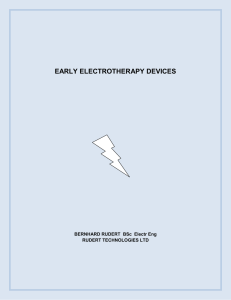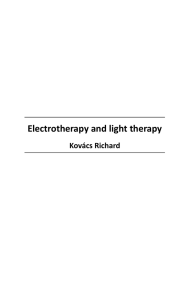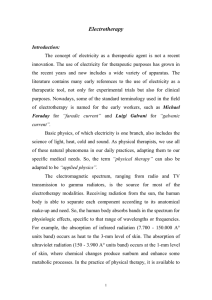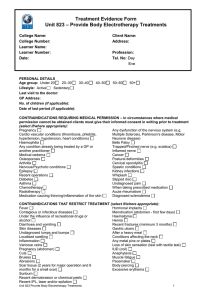Electrotherapy
advertisement
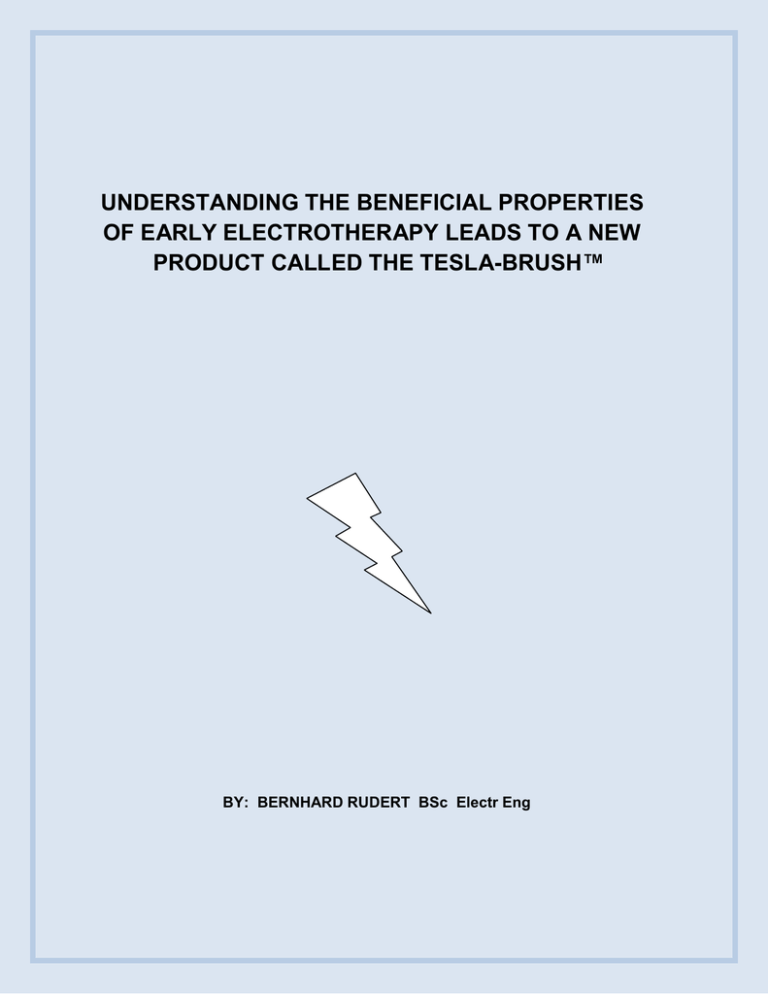
UNDERSTANDING THE BENEFICIAL PROPERTIES OF EARLY ELECTROTHERAPY LEADS TO A NEW PRODUCT CALLED THE TESLA-BRUSH™ BY: BERNHARD RUDERT BSc Electr Eng INTRODUCTION Electrotherapy is nothing new. It was extensively used in the first half of the 20th century claiming to cure all kinds of illnesses. While such claims had merrit specifically regarding skin care, hair loss and pain in general, manufacturers tried to exploit the situation by claiming their equipment would practically cure everything. Eventually the authorities intervened and stopped this exaggeration with the result that this kind of therapy gradually got classified as quackery while the medical profession increasingly relied on the prescription of pharmaceutical products. Early electrotherapy equipment is still used today in beauty spas and by other firm believers in its therapeutic benefits. An example of such a historic hand held device can be seen in Fig.1. To date I have not found any scientific or technical investigation into the therapeutic benefits of this type of outdated equipment and consider this to be the reason for the many unsubstantiated claims regarding its functioning or efficacy. It is my intention to disperse some of these claims and show that the operating principle employed is actually very much supported by our present understanding of electrical stimulation of the physical body. It will also emerge that early electrotherapy devices are in fact another form of today’s frequently used Micro-Current or TENS equipment used for various ailments including pain, with some important superior properties. The subject matter is viewed mainly from a technical perspective relating to the equipment itself with pointers as to where biological or medical benefits could arise. THE ELECTRICAL OPERATING PRINCIPLE Unfortunately I have to use some technical language to lay the foundation for the discussion to follow and trust that you will make sense of my simplified explanations. Fig.2 shows the basic electrical circuit of an early electrotherapy unit. The capacitor “C” is charged by the electrical current source “I” until the energy stored in it reaches a predetermined value while switch “S” is in the position shown. Thereafter switch “S” is activated and connects capacitor “C” across the primary winding of the transformer “T” until all the energy is dissipated. Capacitor “C” together with the inductance of the transformer “T”, form a partially damped oscillating circuit with a frequency usually above 100 KHz. The resulting ringing voltage dies down to zero after a few cycles and then switch “S” returns to the original position. The process is repeated about every 10ms or 100 times per second, which means 1 that at the output of transformer “T” we have very short bursts of a few high voltage peaks separated by long periods of inactivity as shown in Fig.3. The bottom part of Fig.3 shows the short high voltage peaks just as straight lines because the peaks are extremely short. The top part of Fig.3 shows a time magnification of these pulses where you can see the decaying oscillation of the high voltage. The units usually have means of controlling the energy level to which the capacitor “C” is charged or change the repetition rate of the pulses thus making it possible to adjust the output power. In practice the waveform is not always as clean as shown in Fig.3 due to contact bounce in the mechanical switch “S” causing a whole bundle of pulses to occur containing all kinds of harmonic frequencies. The output of transformer “T” is held at ground potential on the one side while the other side is connected to the electrode of a glass tube “N” filled with either neon or argon gas. When the high voltage bursts occur the gas ignites and the glass tube becomes electrically conductive on the inside. Where the glass tube touches the skin of the human body “HB” a small capacitance is created by the electrically insulating glass barrier. Because the high voltage bursts are of a high frequency nature, a small electrical current flows into the skin. Since the body capacitance “BC” is much larger than the barrier capacitance between the glass tube and the skin, the major potential drop occurs across this barrier, which causes numerous tiny sparks to occur on the glass surface. THE EFFECT ON THE SKIN In order to make sense of it all we need to know something about the structure of the human skin which consists of 3 major layers as shown in Fig.4. The outermost layer called the epidermis is the body’s actual protective layer. No blood vessels or nerve endings are found in this layer. It is nourished by the layer below called the dermis. The newly formed cells near the barrier between the dermis and the epidermis are pushing the older cells towards the outer surface of the latter while slowly dying until finally they form a thin layer of flattened dead cells called the stratum corneum which is the actual surface of the skin. The dermis which is below the epidermis is made up of 80% water, elastin fibres and collagen. It contains many blood vessels and nerve endings and plays an important part in temperature 2 regulation and healing. The sweat glands are found in this layer as well as the hair follicles with their arrector pili muscles and their oil glands. Under the dermis we have the hypodermis, also called subcutaneous tissue. The hypodermis consists primarily of loose connective tissue and lobules of fat. It contains larger blood vessels and nerves than those found in the dermis. The blood supply to the hair follicles originates from this layer. To stimulate the skin electrically we need to overcome the often poorly conducting surface formed by the stratum corneum on top of the epidermis. This layer which consists of mainly dead organic matter, is a very poor electrical conductor especially if the skin is dry. For this reason special conductive pads are used for modern electrotherapy treatment. However, if bare metal probes are used as with some skin or hair treating products a moistening liquid is necessary to ensure that electrical current flows into the skin under all circumstances. The dermis and the hypodermis are electrically conductive. Their electrical resistance is a nonlinear function of applied potential. Therefore, for effective stimulation the electrical source requires proper attention. With the instruments used in early electrotherapy the above problems are solved very simply with repeatable results. The reason is that the electrical stimulus is transmitted via the capacitive barrier formed by the glass wall of the electrode together with the insulating properties of the stratum corneum. Because of the high voltage, combined with the high impedance of the barrier capacitance, a reasonably defined electrical current source supplies the dermis with the desired electrical stimulus. This means that the skin must be dry during treatment obviating the need for a special cream to facilitate electrical conduction. We know that the electrical stimulation decreases with the distance from the outer surface of the skin. This means that we need adequate electrical stimulation to reach the hypodermis because the dermis and the hair follicles receive their nourishment from this layer. A much higher electrical stimulus would be required to affect a muscle situated below the hypodermis. It has been established that with a decreasing pulse width especially below 100 microseconds the intensity of the stimulus required to cause muscle contraction increases rapidly. Early electrotherapy units can be considered as having stimulating pulses of less than 5 microseconds and therefore even if they were to produce high currents they would not reach the threshold where muscle contraction occurs. Observing the scalp under a microscope after a few weeks of massaging it regularly once a day for about 10 minutes with an electrotherapy device, small brown spots appear. Further observation over a longer period seems to indicate that where those brown spots appear small fluff starts to develop. My explanation is that the electrical stimulation causes repeated contraction of the arrector pili muscles connected to the follicles thus massaging the latter to clear the clogged pores of excess sebum which softens due to the elctric current. 3 After each massage the skin often gets a slightly rosy color, indicating improved blood flow in the treated area. This suggests that the skin and the follicles are being nourished more effectively. I am not a biologist or dermatologist and therefore cannot explain exactly what happens inside the cellular structure of the skin but I know from results that these early devices do work and that further research in refining the generated wave shape and the construction of the electrodes could prove useful. Some of these early devices cause very strong stimulation, which to my mind is excessive, as I have repeatedly been made to understand that for biological effects higher intensity is not always better. For example I have often been puzzled by the positive effects on pain due to the administaration of minute electrical fields. This may be due to the fact that the human body has its own very small electrical fields which do not need much energy for stimulation. To say that the latter is caused by localized heating is an oversimplification. SOME MYTHS SURROUNDING EARLY ELECTROTHERAPY In the early days nobody really knew the exact working mechanism of the electrotherapy devices and therefore all kinds of special properties were attributed to them. Also numerous different glass shapes were constructed with the perceived aim to facilitate the effectiveness of the equipment for specific ailments. It is no wonder that today’s technologists categorize early electrotherapy as quackery. The subsequent paragraphs are meant to demystify some of these claims which are still upheld by many present day users. The first myth to be unraveled is the classification of early electrotherapy as HIGHFREQUENCY treatment. If we were unfamiliar with the electrical operating principle explained above we would probably assume that the unit puts out a continuous high frequency signal. However, the above description shows that we are dealing with repeated very short bursts of damped high frequency oscillations at a low repetition rate of about 100 times per second. To an engineer this looks more like a pulsed low frequency operation which brings us straight into the domain of today’s popular ‘Micro-Current’ or TENS equipment with well established therapeutic effects. Then there is the notion that a specific high frequency is a critical element for the effectiveness of the therapy. We immediately see the fallacy of this when we realize that the damped high frequency bursts do not have an exact frequency due to big manufacturing tolerances let alone the fact that when the glass tubes touch the skin, the frequency is usually lowered by up to 30%. With modern technology the pulse repetition rate can be controlled very accurately which is more likely to influence the therapeutic effect of the equipment. Some people claim that the effectiveness of the therapy is due to the OZONE produced by the little arcs which are generated around the glass tubes. These can be considered as miniature lightning strikes producing minute amounts of ozone. Since this gas is generated along the entire length of the arcs being perpendicular to the skin, it immediately mixes with the surrounding air whereby most of it is carried away from the surface of the skin. The 4 minuscule amount that gets in touch with the skin could possibly have some beneficial cleansing effect but to my mind is most certainly not a major explanation for the therapeutic effect of the equipment. There are claims that the arc formed when holding the electrode a few millimeters away from the skin creates enough ozone to heal infected areas as for example acne. In my view the small diameter of the arc causes a very high current density at the surface of the skin which destroys bacteria in the area. When the tiny arcs ‘hit’ the skin, they create minute burn marks only visible under a microscope. Since the effect is probably much less than our exposure to the environment we can ignore this effect. However, these little arcs are the only physical sensation felt by the human body. Because this sensation is originating from the surface of the skin, it can be expected that the nerve endings just under the epidermis are stimulated. In addition to the electrical pulse this could be the cause for the possible contraction of the arrector pili muscles clearing the clogged follicle pores as suggested above. It was also observed that a flat mushroom like electrode produced very little arcing, which again would point to the major therapeutic effect of the electrical pulses and not the ozone. Some of the old equipment is specified as having an OUTPUT VOLTAGE of up to 50 KiloVolts. The voltage specification is totally meaningless, because it is the electrical current which flows into the skin that causes the therapeutic effect. Much lower peak output voltages can be used by correctly constructing the glass electrode. I therefore conclude that such high output voltages are required to compensate for a very inefficient device or that the stimulation created is excessive. The output voltage is generated by the high voltage transformer often referred to as the Tesla Coil shown as “T” in Fig.2. There are those who believe that a special construction of the coil according to Nicolas Tesla would have an important influence on the therapeutic outcome, which is totally unacceptable to the rational mind of an engineer because any transformer has clearly defined properties which can be calculated and verified by measurements. Finally I would like to approach the subject of LIGHT generated by the glass electrode. When the glass touches the skin, the neon or argon gas in the glass tube begins to glow. The light is generated only during the very short bursts of damped high frequency oscillations. During that period the light is very bright and will penetrate deeply into the skin. I know that some of the colours in the wide spectrum of light emitted could have a therapeutic effect, provided the light energy is high enough. Since the latter is not the case I consider it sensible to discard this effect. Initial experiments seem to confirm this. On the other hand I do not know how the cells in the skin respond to the light pulses in combination with the electrical stimulus and I may want to investigate this further. The light spectrum for argon gas shows some UV components, while with neon this can be ignored. Because of the low energy levels there is no danger of UV radiation. 5 RELIABILITY ISSUES AND REGULATORY REQUIREMENTS Early electrotherapy devices are highly inefficient causing the handle to get very hot after a while. Furthermore, the high voltage transformer generates enough heat to self-destruct over time mainly due to the melting of the candle wax used for insulation. And then there is the mechanical intensity adjustment which is subject to considerable wear making the devices even more unreliable. Due to the construction, early traditional equipment and modern substitutes all have the common problem of safety. The long glass tubes not only break easily, but when broken can expose the user to dangerous electrical shocks. For this reason manufacturers or marketers state that the intended use is either for experimental purposes only or need to be handled by professionals. Since mandatory safety standards are generally not met the equipment cannot be sold freely on the open market. Another undesirable characteristic of the above equipment is the huge amount of radio interference generated. In order to meet mandatory standards set by the FCC or CE the equipment would become not only bulky but could lose its therapeutic effect if the problem is not handled skillfully. Therefore, this further limits the equipment being sold freely on the open market. NEW TECHNOLOGY With all the evidence of effectiveness of early electrotherapy it is interesting to note that nobody has thought of making devices suitable for general household use, meeting modern mandatory regulatory standards. The Internet offers numerous alternative devices powered by some simple electronic circuits. Not only are these devices potentially unsafe and emit excessive electrical interference they are not allowed in most countries. They are generally unreliable because of the inadequate quality of the high voltage transformer, while the fragile glass electrodes require frequent replacement. Third party liability could become very expensive in case of an accident. To make sure that a device meets mandatory regulatory standards, it is sensible to request copies of valid relevant compliant certificates from the manufacturer prior to purchase. Manufacturing an economic hand-held device meeting the required specifications necessitates certain special electronic components which were not available in the 20th century. Using latest technology led me to develop a robust, long lasting, hand-held battery operated device which can be used anywhere while overcoming all the above mentioned limitations. Since the product is software driven beneficial massage modalities can be incorporated. 6 CONCLUSION From the above we conclude that early electrotherapy uses devices producing very short fast decaying high frequency pulses at a low repetition rate. Due to the construction of its electrical source, the stimulating pulses reliably reach the dermis, in spite of the insulating properties of the stratum corneum, which is a great advantage over modern Micro-Current and TENS equipment for certain applications. Furthermore the low intensity very short stimulating pulses result in a comfortable form of therapy without any danger of muscle contractions. While the therapeutic benefits of early electro therapy equipment is well known, it cannot be marketed because it does not meet mandatory regulatory standards. With modern electronic components it is possible to design an equivalent device with outstanding reliability and performance meeting all required standards. Bernhard S. Rudert BSc Eng. Copyright © 2011 – 2012 Bernhard S. Rudert 7
